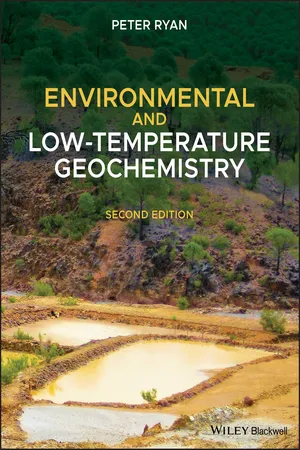
- English
- ePUB (mobile friendly)
- Available on iOS & Android
Environmental and Low-Temperature Geochemistry
About this book
Environmental and Low-Temperature Geochemistry presents conceptual and quantitative principles of geochemistry in order to foster understanding of natural processes at and near the earth's surface, as well as anthropogenic impacts and remediation strategies. It provides the reader with principles that allow prediction of concentration, speciation, mobility and reactivity of elements and compounds in soils, waters, sediments and air, drawing attention to both thermodynamic and kinetic controls. The scope includes atmosphere, terrestrial waters, marine waters, soils, sediments and rocks in the shallow crust; the temporal scale is present to Precambrian, and the spatial scale is nanometers to local, regional and global.
This second edition of Environmental and Low-Temperature Geochemistry provides the most up-to-date status of the carbon cycle and global warming, including carbon sources, sinks, fluxes and consequences, as well as emerging evidence for (and effects of) ocean acidification. Understanding environmental problems like this requires knowledge based in fundamental principles of equilibrium, kinetics, basic laws of chemistry and physics, empirical evidence, examples from the geological record, and identification of system fluxes and reservoirs that allow us to conceptualize and understand. This edition aims to do that with clear explanations of fundamental principles of geochemistry as well as information and approaches that provide the student or researcher with knowledge to address pressing questions in environmental and geological sciences.
New content in this edition includes:
- Focus Boxes – one every two or three pages – providing case study examples (e.g. methyl isocyanate in Bhopal, origins and health effects of asbestiform minerals), concise explanations of fundamental concepts (e.g. balancing chemical equations, isotopic fractionation, using the Keq to predict reactivity), and useful information (e.g. units of concentration, titrating to determine alkalinity, measuring redox potential of natural waters);
- Sections on emerging contaminants for which knowledge is rapidly increasing (e.g. perfluorinated compounds, pharmaceuticals and other domestic and industrial chemicals);
- Greater attention to interrelationships of inorganic, organic and biotic phases and processes;
- Descriptions, theoretical frameworks and examples of emerging methodologies in geochemistry research, e.g. clumped C-O isotopes to assess seawater temperature over geological time, metal stable isotopes to assess source and transport processes, X-ray absorption spectroscopy to study oxidation state and valence configuration of atoms and molecules;
- Additional end-of-chapter problems, including more quantitatively based questions.
- Two detailed case studies that examine fate and transport of organic contaminants (VOCs, PFCs), with data and interpretations presented separately. These examples consider the chemical and mineralogical composition of rocks, soils and waters in the affected system; microbial influence on the decomposition of organic compounds; the effect of reduction-oxidation on transport of Fe, As and Mn; stable isotopes and synthetic compounds as tracers of flow; geological factors that influence flow; and implications for remediation.
The interdisciplinary approach and range of topics – including environmental contamination of air, water and soil as well as the processes that affect both natural and anthropogenic systems – make it well-suited for environmental geochemistry courses at universities as well as liberal arts colleges.
Frequently asked questions
- Essential is ideal for learners and professionals who enjoy exploring a wide range of subjects. Access the Essential Library with 800,000+ trusted titles and best-sellers across business, personal growth, and the humanities. Includes unlimited reading time and Standard Read Aloud voice.
- Complete: Perfect for advanced learners and researchers needing full, unrestricted access. Unlock 1.4M+ books across hundreds of subjects, including academic and specialized titles. The Complete Plan also includes advanced features like Premium Read Aloud and Research Assistant.
Please note we cannot support devices running on iOS 13 and Android 7 or earlier. Learn more about using the app.
Information
1
Background and Basic Chemical Principles: Elements, Ions, Bonding, Reactions
1.1 An Overview Of Environmental Geochemistry – History, Scope, Questions, Approaches, Challenges for the Future
The best way to have a good idea is to have a lot of ideas. (Linus Pauling)
All my life through, the new sights of nature made me rejoice like a child. (Marie Curie)
I must speak of the soil hiding the rocks, of the lasting river destroyed by time. (Pablo Neruda)
Focus Box 1.1
Defining “Low‐Temperature”
Table of contents
- Cover
- Table of Contents
- Preface
- Acknowledgements
- 1 Background and Basic Chemical Principles: Elements, Ions, Bonding, Reactions
- 2 Surficial and Environmental Mineralogy
- 3 Organic Compounds in the Environment
- 4 Aqueous Systems and Water Chemistry
- 5 Carbonate Geochemistry and the Carbon Cycle
- 6 Biogeochemical Systems and Cycles (N, P, S)
- 7 The Global Atmosphere: Composition, Evolution, and Anthropogenic Change
- 8 Air Quality: Urban and Regional Pollutants
- 9 Chemical Weathering, Soils, and Hydrology
- 10 Stable Isotope Geochemistry
- 11 Radioactive and Radiogenic Isotope Geochemistry
- Appendix I: Case Study on the Relationships Among Volatile Organic Compounds (VOCs), Microbial Activity, Redox Reactions, Remediation, and Arsenic Mobility in GroundwaterCase Study on the Relationships Among Volatile Organic Compounds (VOCs), Microbial Activity, Redox Reactions, Remediation, and Arsenic Mobility in Groundwater
- Appendix II: Case Study of PFOA Migration in a Fractured Rock Aquifer: Using Geochemistry to Decipher Causes of HeterogeneityCase Study of PFOA Migration in a Fractured Rock Aquifer: Using Geochemistry to Decipher Causes of Heterogeneity
- Appendix III: Instrumental AnalysisInstrumental Analysis
- Appendix IV: Table of Thermodynamic Data of Selected Species at 1 atm and 25 °CTable of Thermodynamic Data of Selected Species at 1 atm and 25 °C
- Index
- End User License Agreement